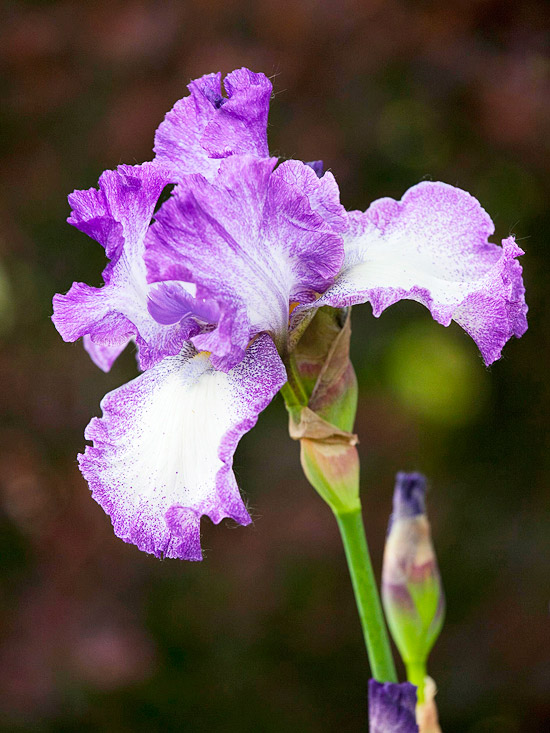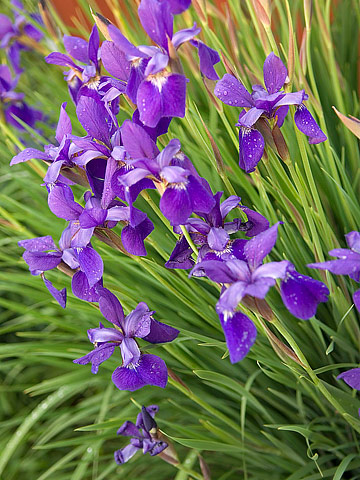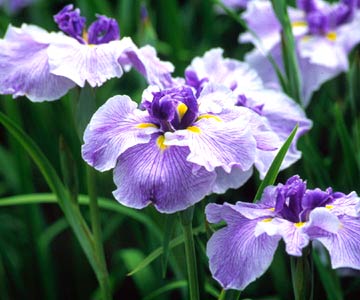






Of the flowers that inspire passionate devotees, iris flowers are one of the most popular. There are bulletins that espouse their beauty, societies that gather to discuss them, and growers that are dedicated solely to growing them. Kelly D. Norris is one of them. "I've been gardening since I was 4 years old with my grandmothers, and I've always been bewitched by the rainbow of irises," says Norris, who is farm manager of the Rainbow Iris Farm, author of Cultivating the Rainbow, and editor of Irises: The Bulletin of The American Iris Society. "They come in every color of the rainbow, in every permutation you can imagine. On this continent, if you need to garden outdoors with plants that are relatively hardy, irises are the only group that have as much color or bang that you can plant."
But for all their popularity and beauty, irises are often misunderstood by gardeners. Whether you're interested in an accent plant or a whole bed planted only with iris flowers, here's what you need to know.
continue reading below
In a loose horticulture sense, irises -- and there are 325 species and 50,000 registered varieties -- can be divided into two categories: bearded and beardless, which include Japanese or Siberian. "The names they came up with weren't too terribly inventive, but the classification is incredibly complicated and controversial," Norris says. "In many cases, people are most familiar with bearded varieties. Beardless irises have signals in place of beards."
The differences, though, are more than the appearance or lack thereof of a floral appendage. In general, bearded irises like good, steady, constant drainage. "They do not want their feet wet," Norris says. "They can tolerate heavy soils as long as there is a chance they'll get a reprieve."
That makes bearded iris flowers good xeriscaping plants, meaning they have the ability to withstand droughts. They also have the remarkable ability to fit in a wide range of gardens -- from a cute garden island in Nantucket to a desert-theme plot in Tucson. "In general, irises are a good solution plant: Give me a spot where you want to put them, and I can find one that will work there," Norris says. "I love the beauty of bearded irises. My grandmother grew them, my mom grew them; I have a strong floral heritage connection to them."
Bearded iris flowers are also further subdivided into six kinds based on size, and some of the smaller ones -- particularly dwarfs -- don't like overhead competition. Beardless irises tend to have more grassy-looking foliage. "Siberians, in particular, don't suffer as much from overhead competition and can fare a lot better over the long term depending on the way the planting is composed," Norris says. "They're very forgiving in a sense."
Beardless iris flowers also include Japanese irises, which don't like standing water and prefer more acidic soil; Virginia irises, which love water and typical garden soil; and crested irises, which do great in dry shade. And don't think that irises are done adding to that list: There are almost 1,000 new varieties of both types of irises each year.

With one exception -- Juno iris flowers -- all irises are rhizomes. While a rhizome resembles a bulb and performs a similar function, it is completely different from a technical plant growth perspective. "A rhizome is a modified stem that grows at or just below ground level and is supposed to store energy," Norris says. "While bulbs are underground structures, rhizomes need to be close to the soil surface."
The type of iris also comes into play when planting its rhizome. Bearded irises should be planted shallowly and anchored. For loamy or clay soil, plant almost at the surface with a little pat of soil at the top. In lighter soil or extremely hot climates, the planting depth should be up to 1-1/2 inches. "You don't want a lot of excess moisture at the rhizome, which can lead to rot or borers," Norris says. "But you also need to keep the rhizomes from getting burned at the surface, so you need to insulate them, too."
The rhizomes of bearded and beardless irises look different, too. Beardless Siberians, for example, resemble more knobby fingers as opposed to tubers, with much more texture and a different crown structure, Norris says.
Once they're established, irises have to be divided, but how often also depends on the type. Beardless irises can go longer without having to be divided -- 3, 5, or even 7 years -- but Siberians take a little longer to get established. "They're worth the wait and reward," Norris says.
Bearded irises need to be divided about every 3 to 5 years, and some require it every year. "If they're not divided, their flowering goes downhill and their health goes downhill, so it's a pretty painless effort," Norris says.
Division is easy; all you need is a sharp knife or a potato fork. Simply dig up a mass of overgrown iris, break it into the least reducible chunk, and either plant elsewhere or share. "One of my favorite things to do is to take boxes of them to friends," Norris says.
For all their beauty and range, irises are not without maladies; the two biggest are soft rot and borers. "Rot, caused by a common bacteria, is a universal problem," Norris says. "The rhizomes get mushy and spongy with a foul smell."
In wetter years, too much water can be held around the crown of the plant, which allows bacteria land, settle on fallen leaves, and leave an unpleasant mess. The solution, Norris says, is fairly easy: Dig up the whole clump, divide it, and dip those pieces, chunks, or clumps in a solution of 50 percent bleach, 50 percent water for up to an hour. You also may want to find a different spot to replant the clumps.
Borers are a separate, although related, problem that occurs in the eastern two-thirds of the country. There are a few products that might work, but the best option is to prevent or control borers. Start by keeping your iris flowerbeds free of debris: Clean them up in spring and fall, removing dead foliage from the crowns. In addition, don't mulch too heavily around irises and don't cover the rhizome or crown with mulch. Otherwise, the organic matter collects, creating little nests in which moths land and hatch their eggs. "Often you do not know you have them until they are gone, and they leave behind rot," Norris says. "Give your irises some breathing room."
See different varieties of iris.
Copyright © www.100flowers.win Botanic Garden All Rights Reserved